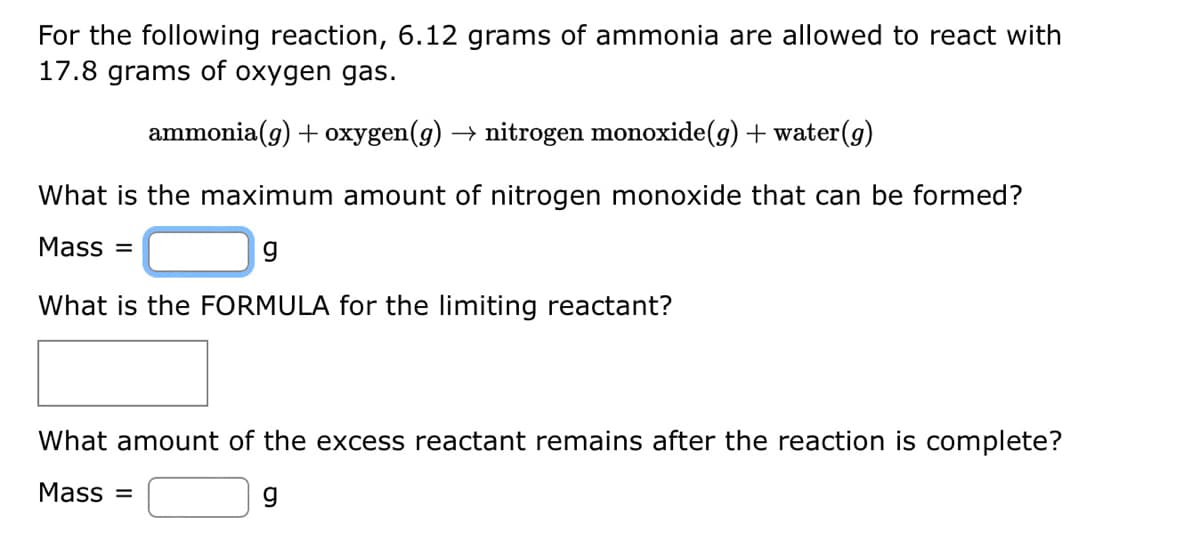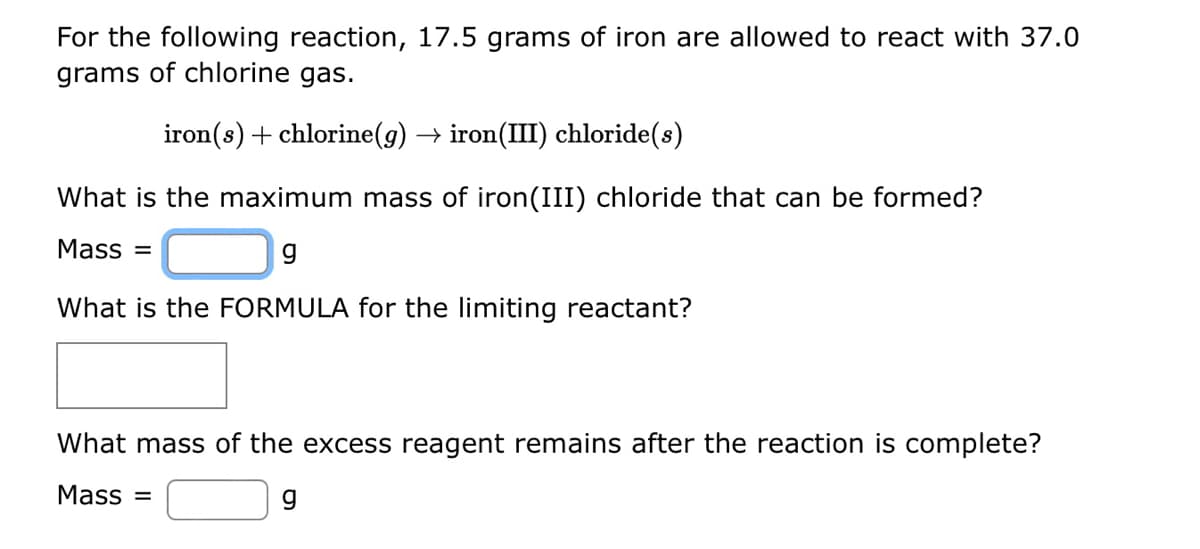For the following reaction, 6.12 grams of ammonia are allowed to react with 17.8 grams of oxygen gas. ammonia(g) + oxygen(g) → nitrogen monoxide(g) + water (g) What is the maximum amount of nitrogen monoxide that can be formed? Mass = g What is the FORMULA for the limiting reactant? What amount of the excess reactant remains after the reaction is complete? Mass= g
For the following reaction, 6.12 grams of ammonia are allowed to react with 17.8 grams of oxygen gas. ammonia(g) + oxygen(g) → nitrogen monoxide(g) + water (g) What is the maximum amount of nitrogen monoxide that can be formed? Mass = g What is the FORMULA for the limiting reactant? What amount of the excess reactant remains after the reaction is complete? Mass= g
General, Organic, and Biological Chemistry
7th Edition
ISBN:9781285853918
Author:H. Stephen Stoker
Publisher:H. Stephen Stoker
Chapter6: Chemical Calculations: Formula Masses, Moles, And Chemical Equations
Section: Chapter Questions
Problem 6.75EP: The catalytic converter that is standard equipment on American automobiles converts carbon monoxide...
Related questions
Question

Transcribed Image Text:For the following reaction, 6.12 grams of ammonia are allowed to react with
17.8 grams of oxygen gas.
ammonia(g) + oxygen(g) → nitrogen monoxide(g) + water (g)
What is the maximum amount of nitrogen monoxide that can be formed?
Mass =
g
What is the FORMULA for the limiting reactant?
What amount of the excess reactant remains after the reaction is complete?
Mass=
g

Transcribed Image Text:For the following reaction, 17.5 grams of iron are allowed to react with 37.0
grams of chlorine gas.
iron(s) + chlorine(g) → iron(III) chloride(s)
What is the maximum mass of iron(III) chloride that can be formed?
Mass =
9
What is the FORMULA for the limiting reactant?
What mass of the excess reagent remains after the reaction is complete?
Mass=
g
Expert Solution
This question has been solved!
Explore an expertly crafted, step-by-step solution for a thorough understanding of key concepts.
This is a popular solution!
Trending now
This is a popular solution!
Step by step
Solved in 2 steps with 1 images

Knowledge Booster
Learn more about
Need a deep-dive on the concept behind this application? Look no further. Learn more about this topic, chemistry and related others by exploring similar questions and additional content below.Recommended textbooks for you

General, Organic, and Biological Chemistry
Chemistry
ISBN:
9781285853918
Author:
H. Stephen Stoker
Publisher:
Cengage Learning

Chemistry for Engineering Students
Chemistry
ISBN:
9781285199023
Author:
Lawrence S. Brown, Tom Holme
Publisher:
Cengage Learning

General Chemistry - Standalone book (MindTap Cour…
Chemistry
ISBN:
9781305580343
Author:
Steven D. Gammon, Ebbing, Darrell Ebbing, Steven D., Darrell; Gammon, Darrell Ebbing; Steven D. Gammon, Darrell D.; Gammon, Ebbing; Steven D. Gammon; Darrell
Publisher:
Cengage Learning

General, Organic, and Biological Chemistry
Chemistry
ISBN:
9781285853918
Author:
H. Stephen Stoker
Publisher:
Cengage Learning

Chemistry for Engineering Students
Chemistry
ISBN:
9781285199023
Author:
Lawrence S. Brown, Tom Holme
Publisher:
Cengage Learning

General Chemistry - Standalone book (MindTap Cour…
Chemistry
ISBN:
9781305580343
Author:
Steven D. Gammon, Ebbing, Darrell Ebbing, Steven D., Darrell; Gammon, Darrell Ebbing; Steven D. Gammon, Darrell D.; Gammon, Ebbing; Steven D. Gammon; Darrell
Publisher:
Cengage Learning

Chemistry: An Atoms First Approach
Chemistry
ISBN:
9781305079243
Author:
Steven S. Zumdahl, Susan A. Zumdahl
Publisher:
Cengage Learning

Chemistry for Engineering Students
Chemistry
ISBN:
9781337398909
Author:
Lawrence S. Brown, Tom Holme
Publisher:
Cengage Learning

Chemistry: The Molecular Science
Chemistry
ISBN:
9781285199047
Author:
John W. Moore, Conrad L. Stanitski
Publisher:
Cengage Learning